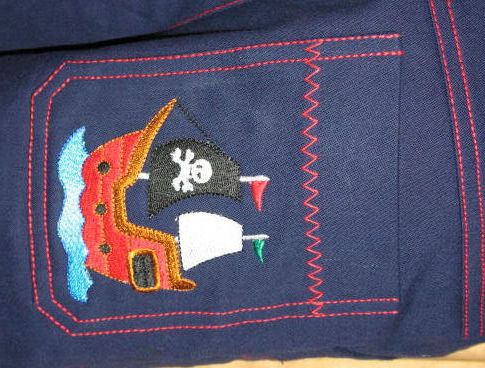Hi, I'm Melissa from Susie-Homemaker and Joanna has asked me to guest blog a post on sewing pants. Honestly I'm not sure I'm qualified to type this post, but like I told Joanna in my email, I really just sew by the seat of my pants and figure it out as I go. When I'm stumped, I consult Google, my shelf full of sewing books, and favorite sewing message board Pattern Review, but mostly I just wing it and learn from my mistakes.
I have quite a bit of pant sewing experience under my belt thanks to my four children. I enjoy sewing for them because they are easy to fit. Me on the other hand, I'm still on a quest to sew pants that fit me perfectly. I don't fit the classic "perky thin 20-year-old-Barbie-doll body type model" that pattern makers draft for, but what woman does? A quick look around in any public venue and you'll see that body type does not depict your typical woman's curvy figure. I make a point to note this because sewing pants is the easy part, getting them to fit how you like, well that is another story and one I'm definitely not qualified to write about. Okay, on to sewing by the seat of our pants!
 So what kinds of fabrics do you sew pants from? The easy answer is anything you want. Of course use this guide within reason. Most people don't sew pants from a sheer lightweight fabric, but if you really wanted to you could. Some popular choices for sewing pants include denim, twill, corduroy, and linen. If you're using a commercial pattern, you'll find a list of suggested fabrics on the pattern envelope. Definitely use that information as a guide because it will help you recreate the look you see on the pattern envelope ~ too stiff or too drapey and you'll ruin the look.
So what kinds of fabrics do you sew pants from? The easy answer is anything you want. Of course use this guide within reason. Most people don't sew pants from a sheer lightweight fabric, but if you really wanted to you could. Some popular choices for sewing pants include denim, twill, corduroy, and linen. If you're using a commercial pattern, you'll find a list of suggested fabrics on the pattern envelope. Definitely use that information as a guide because it will help you recreate the look you see on the pattern envelope ~ too stiff or too drapey and you'll ruin the look.

 What about needles and stitch length? This all depends on the fabric you choose. A light weight fabric will require a small needle while a heavyweight fabric needs a larger needle that will penetrate the thicker fabric and not cause stress on the thread which can cause it to fray or break. As a general guide, lightweight fabric you'll use 60/9 or 70/10 with a stitch length of 1.5-1.7mm, a medium weight fabric 70/10 or 80/20 with a stitch length of 2-2.5mm, heavyweight fabric 90/14 or 100/16 with a stitch length of 2.5-3mm, and then a very heavyweight fabric 100/16 to 120/20 with a stitch length of 3-4mm. To ensure you're using the correct needle and stitch length, create a few samples with your fabric scraps before beginning your garment.
What about needles and stitch length? This all depends on the fabric you choose. A light weight fabric will require a small needle while a heavyweight fabric needs a larger needle that will penetrate the thicker fabric and not cause stress on the thread which can cause it to fray or break. As a general guide, lightweight fabric you'll use 60/9 or 70/10 with a stitch length of 1.5-1.7mm, a medium weight fabric 70/10 or 80/20 with a stitch length of 2-2.5mm, heavyweight fabric 90/14 or 100/16 with a stitch length of 2.5-3mm, and then a very heavyweight fabric 100/16 to 120/20 with a stitch length of 3-4mm. To ensure you're using the correct needle and stitch length, create a few samples with your fabric scraps before beginning your garment.
 Another question that comes up regarding needles is what type. I found a very helpful post on the Sew Mama Sew blog so I'm going to refer everyone to that so I don't reiterate the same information. Worth adding is a little information about stretch needles. Stretch needles are actually a better choice when sewing fabrics with spandex (aka Lycra) because they have a deeper scarf that prevents skipped stitches. I have personally had skipped stitches using a ball point needle, but once I switched to a stretch needle the problem has been solved. Here is another helpful reference for choosing needles.
Another question that comes up regarding needles is what type. I found a very helpful post on the Sew Mama Sew blog so I'm going to refer everyone to that so I don't reiterate the same information. Worth adding is a little information about stretch needles. Stretch needles are actually a better choice when sewing fabrics with spandex (aka Lycra) because they have a deeper scarf that prevents skipped stitches. I have personally had skipped stitches using a ball point needle, but once I switched to a stretch needle the problem has been solved. Here is another helpful reference for choosing needles. What about thread? For stitching seams, a basic all-purpose thread is perfect for most of your sewing needs. I typically use Coats & Clark Dual Duty XP which I buy at Joann's. When I topstitch hems or pockets, I use the same all-purpose thread when I want everything to blend together. Other times I want thicker topstitching thread to highlight those areas (hems, pockets, etc), so I use Gutermann topstitching thread (also at Joann's). While I don't recall the price of the spool, it has 110 yds and comes in several different colors including a nice blue jeans gold (#1870). When I topstitch, I have personally used a regular sewing machine needle, but after doing a little research for this post, I see I should really be using a topstitching needle because they are made for thicker topstitching thread (note to self!). Sometimes you'll have to loosen the thread tension to get the bobbin and the needle thread to balance out so it's best to practice on scraps first. Also, I personally use all-purpose thread in my bobbin when I topstitch because it feeds better (at least in my machine) than the thick topstitching thread. I think that you're really only supposed to use lighter weight threads in your bobbin case, but consult your manual or your dealer for what is correct for your machine.
What about thread? For stitching seams, a basic all-purpose thread is perfect for most of your sewing needs. I typically use Coats & Clark Dual Duty XP which I buy at Joann's. When I topstitch hems or pockets, I use the same all-purpose thread when I want everything to blend together. Other times I want thicker topstitching thread to highlight those areas (hems, pockets, etc), so I use Gutermann topstitching thread (also at Joann's). While I don't recall the price of the spool, it has 110 yds and comes in several different colors including a nice blue jeans gold (#1870). When I topstitch, I have personally used a regular sewing machine needle, but after doing a little research for this post, I see I should really be using a topstitching needle because they are made for thicker topstitching thread (note to self!). Sometimes you'll have to loosen the thread tension to get the bobbin and the needle thread to balance out so it's best to practice on scraps first. Also, I personally use all-purpose thread in my bobbin when I topstitch because it feeds better (at least in my machine) than the thick topstitching thread. I think that you're really only supposed to use lighter weight threads in your bobbin case, but consult your manual or your dealer for what is correct for your machine. Before I close, I'd like to share a few links of things you might find helpful for the sewalong. Here are two articles ~ Making Perfect Pants and Sewing Instructions for Women's Pants. And if you're interested in learning to better fit your clothes to your body shape, I highly recommend two books by Pati Palmer & Marta Alto ~ Fit For Real People and Pants for Real People. Lastly, there are two books I have in my sewing library that are great pants reference books ~ Easy Guide to Sewing Tops, T-Shirts, Skirts, and Pants & Sewing Pants That Fit (this one is a bit dated, but has good information on sewing and fitting pants).
Before I close, I'd like to share a few links of things you might find helpful for the sewalong. Here are two articles ~ Making Perfect Pants and Sewing Instructions for Women's Pants. And if you're interested in learning to better fit your clothes to your body shape, I highly recommend two books by Pati Palmer & Marta Alto ~ Fit For Real People and Pants for Real People. Lastly, there are two books I have in my sewing library that are great pants reference books ~ Easy Guide to Sewing Tops, T-Shirts, Skirts, and Pants & Sewing Pants That Fit (this one is a bit dated, but has good information on sewing and fitting pants).
Thank you Joanna for asking me to be a guest. I hope the information I shared will be useful. My best advice is don't think about it too much. I get caught up in thinking too much and sometimes I think the best things happen when you just roll with it and really just sew by the seat of your pant. Happy sewing!







9 comments:
Thank you Susie and Joanna. Great post.
Great tutorial! I still have the Jalie jeans waiting to be finished.LOL Do you know how awesome your top stitching is??? Seriously!
Someday I'll attempt pants, and I'll have to refer back to this excellent post.
Those are some cute pants.
You have a great blog. I'd love for you to come and visit my blog. I just made a Vintage Vogue Original 1944 Design, V2858. On the previous page you'll find a dress I made from an original 1974 pattern that I found in an antique store. I call that post The Lady in Lavender. And lots of other things in between. Hope you enjoy.
You are the pant queen...I bow to you.
BTW, there is a vegan pumpkin soup recipe up at my place...something I'm sure your big hunk of a hubby would just looooove!
Wow, you make me want an embroidery machine. You do fabulous work.
How cool that you were asked to do a guest post. For some reason, I'm not getting the pictures on your blog. There is a big space for your header, but it's not there either.
Oh, and belated congratulations on your anniversary!
This blog is very interesting and entertainment. i liked a lot. i think it is very dinamic. Absolutely wonderful and notable I was impressive with all this amazing information.
buy viagra
Wow!! This is looking so cool and smooth...
That fabric is very nice and that prints is very pretty...
to get fabric on demand from weaveron textile.
Post a Comment